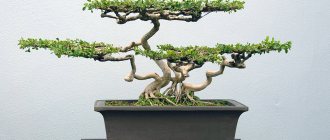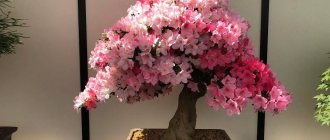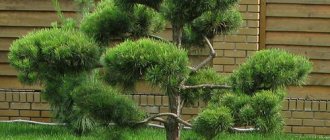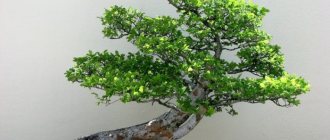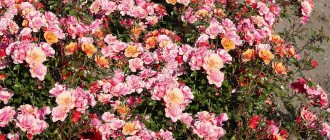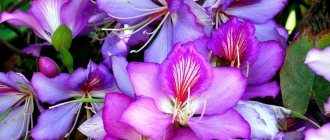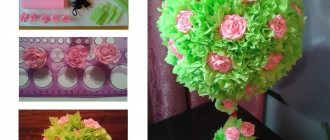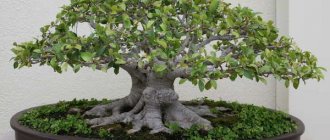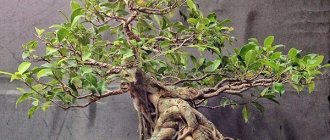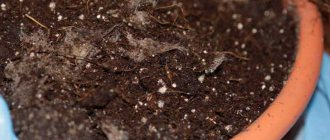Bonsai is a gardening art whose purpose is to grow a decorative miniature tree. Imagine pine, cedar or maple growing in a small pot on the windowsill!
The hundred year old maple and scarlet begonias look amazing!
This art appeared in Japan more than 2 thousand years ago, then migrated to China, and about a century ago it became popular throughout the world. Let's talk about how to grow bonsai, how to choose a plant, soil, pot, how to form a crown, etc.
How to choose a plant for bonsai
You can grow bonsai of any type: all deciduous and coniferous trees, flowering or decorative deciduous. Any of them will (and should) repeat the natural cycle. The best choice is plants with small leaves and a lot of branches.
Typically, a bonsai tree is no more than half a meter in height. And superminiature ones can be up to 3 cm. Huge bonsai are only 150 cm and no more
There are specific species recommended for bonsai:
- Japanese quince, wild, Chinese;
- hawthorn;
- small-leaved elm, squat;
- Canadian spruce, common;
- common larch;
- Chinese juniper;
- aspen;
- ficuses (almost all, but the best is Benjamina);
- small-fruited apple tree (may have red or green leaves), wild;
You can keep bonsai both in the house and in the garden. Choose a location for each individual. It is not recommended to change it.
Every season has its own charm
Please note that deciduous plants will change color and shed leaves in the fall, and bud and bloom in the spring. If you don't want to see bare branches in winter, choose something evergreen. For example, conifers or other evergreen species.
For beginners, the best choice is ficus benjamina. It grows quickly, has small shiny leaves and a trunk that thickens on its own. Already at 5 years it will look like an old tree.
Form your first bonsai from ficus benjamina
At the same time, you can try to grow a coniferous or deciduous seedling. At the same time you will understand the difference.
Watering bonsai from coniferous trees
Evergreen rocks such as spruce, pine, juniper, cedar, and cypress are often used to form miniatures due to their hardiness - they easily survive prolonged drought, lack of nutrients, and do well on rocky soil. However, this does not mean that coniferous bonsai can be left completely without water. The younger the plant, the more attention should be paid to it, if possible avoiding the soil from drying out completely.
ms_bew_11.jpg
In order for living sculptures in the Japanese style to always delight others with a healthy appearance, it is advisable to water them as needed - as soon as the surface dries to a depth of 2-3 centimeters. This rule remains relevant in winter, since from December to March coniferous crops do not fall asleep, like deciduous crops, and sap continues to actively circulate through them.
7c4a1b1ff18c6ac7968a2a0c3cd9941b.jpg
Outdoor trees can receive moisture from precipitation, but during hot periods it is still worth using a garden hose or watering can. Stabilized moss, dry needles, wood shavings or sawdust covering the ground around the trunk will help reduce water loss.
dsc_0024.jpg
Bonsai styles
This art is more than two thousand years old, so there are more than two dozen main styles alone. The very first thing to do is to choose the style in which you will form your miniature tree.
Basic Bonsai Tree Styles
Please note that styles differ not only in the presence or absence of a slope, the number of trunks, but also in the location of the main branches. If you like a particular style, find its detailed description and several photographs. All this will be required when forming the trunk and crown.
And these are not the smallest ones
There is also a division of bonsai trees by size. There are five main classes, and three of them also have gradations. The sizes of bonsai trees are shown in the table below. There are also Russified analogues of Japanese/Chinese names.
| Class | Subclass | Bonsai tree height | Russian name | Bonsai Pot Dimensions |
| Mame | Keshi-Tsubu | less than 2.5 cm | Tiny | 3-8 cm |
| Sieve | from 2.5 cm to 7.5 cm | 5-10 cm | ||
| Gafu | from 8 cm to 3 cm | 10-15 cm | ||
| Sehin | Komono | from 13 cm to 17 cm | Small | 12-20 cm |
| Myabi | from 18 cm to 25 cm | 15-25 cm | ||
| Kifu | Katade Mochi | up to 40 cm | Average | 25-46 cm |
| Tyu/Tyukhin | Katade Mochi | from 40 cm to 60 cm | Big | 40-90 cm |
| Omono | from 60 cm to 120 cm | |||
| Dai/Daiza | Bonju | more than a meter | Huge | 75-125 cm |
Techniques (methods) for growing them
Next, we decide on the start. There are three techniques for growing bonsai trees:
- from seeds (it will take 12-15 years to form a bonsai-like plant);
- from seedlings (minimum period - 5-7 years);
- cuttings (some species will look like bonsai after 4-5 years).
Advice for beginners: form one or two seedlings, and grow another ten, twenty or thirty.
With any growing method, the plant in the “starter” pot is grown to the desired height. The formation of the crown and bending of the trunk occurs while the “blank” is growing. A ready-made mini-tree that has finished growing is transferred to an “adult” pot.
What to do with the seeds
If you decide to germinate from seeds, place them in a container with moss for the cold season and place them on the bottom shelf in the refrigerator. Until spring. Cold temperatures prepare the seed to grow as the weather warms. This process is called stratification. In the spring, plant the seeds in the ground, keep the soil slightly moist, but do not let it sour. Sprouts will quickly appear and immediately begin to grow.
Seeds can be germinated in egg trays
Stratification is necessary for plants in our climate zone. Germinate tropical tree seeds after soaking them in water for 24 hours.
The hatched seeds are watered and left to grow. When they are more than 10 cm high, you can transfer each one to its own pot, wait a couple of months until they take root, and begin formation.
Choosing seedlings
Grow a bonsai from a seedling faster. They are planted in the fall. It will be much easier if you buy a selected and prepared plant in a specialized store or garden center.
In general, seedlings can be found in the forest, but it is better on a roof, on a rock or a fence. Where there is not enough soil. The plant should be no more than 15-20 cm high. It is desirable that it already has enough lateral branches.
Seedlings can be bought at a specialty store or found in the forest. To make it clearer what to choose, the right one at the plate is simply perfect. Cut off the excess during the formation process and get a decorative crown
If you dig, grab some of the “native” soil - adaptation will be easier. Allow the plant to take root in the pot until spring.
Bonsai cuttings
You will have to take cuttings for exotic plants such as ficus, figs, tea tree, etc. They are cut off in the spring from mature plants (before young buds appear) from the trunk itself. The length of the cutting is about 25 cm. Ideally, there should be several side branches. We cut off the upper, too soft part of the cutting parallel to the ground. We also cut off the lower one, which is too hard, but at an angle. We remove the lower leaves; if there are large ones, cut off most of them, leaving half a leaf.
Cuttings must be strong
Dip the bottom cut into the rooting agent.
Phytoclon - an effective gel for rooting plant cuttings
The cuttings can be kept in water until roots appear or immediately planted in a clay pot (regular) with ordinary garden soil. The cut should be deepened by 5-7 cm. Place the pot/jar with cuttings in the shade and water regularly. When new leaves appear, gradually move the pot to a more illuminated place, but not into open sun. Feed once a month. Grow the seedling for a year or two until it reaches the desired height.
Light modes for bonsai maintenance
Conditions of light regimes for growing bonsai, light technologies, description and photo.
It is known that in the territories of our region the climate is not ideal for growing bonsai. The presented fact also negatively affects light factors. The whole difficulty is that our days end quite quickly, but in tropical or subtropical regions, the days last much longer. Fans of Japanese technology decided to go against all climatic conditions and create their own. In the modern world, there are many different lighting systems, with the help of which a miniature tree will not experience a lack of light.
Let's consider the time intervals of bonsai development when the most light is needed. This is, naturally, the winter period. The greatest deficit of solar color occurs in mini-trees in cold sub-zero temperatures. As soon as the end of October comes, it is worth helping the bonsai with lighting; similar assistance should last until approximately the beginning of the month of March. This article will indicate standard rules intended for bonsai with fundamental characteristics.
Research has proven that as many different types of plants as there are, there are as many conditions for keeping them. Therefore, before purchasing a baby bonsai, you need to be fully familiar with all the characteristics and features of the tree. There are several basic information rules that need to be taken into account when choosing a place to keep an oriental plant; they are valid for all varieties of Japanese technology.
So, we present the basic lighting parameters. Firstly, what needs to be taken into account is the cardinal direction. We often notice in our homes that, despite the same temperature outside the window, in the house in each of the rooms there are different temperature signs, this depends on where the sunny and where the less sunny zone is. It is no secret that bonsai loves warmth, so it would not be a mistake to place the flower in the sunniest place. Secondly, a certain distance from the window. If the tree is in the warmest place in the whole house, then where exactly to place the bonsai does not matter much, the main thing is that it is near the window. For example, on the windowsill, near the window behind the curtains, or by the window if there are no curtains, somewhere in the room. The main task is to ensure that the tree receives direct sunlight. It is necessary to carefully look to see if there is anything that prevents the bonsai from living in the sun. Even the smallest variety of indoor plants can be obstacles, not to mention large houses or planted trees, which completely take away the bonsai’s ability to bathe in the sun’s rays. Also, when choosing a place for a plant, you should be aware of the fact that curtains tend to absorb sunlight, therefore, if the tree is located behind them, it is necessary to lift or move the curtains to the side during the day. In the presented way, the provision of natural lighting for the variety is guaranteed.
It is known that the sun's rays fall at different angles. Therefore, it is worth talking about where exactly the bonsai will feel more comfortable. There are two comfortable zones. The first one is on the east window on the left side, or the second one is on the west window on the right side. It is almost impossible to guess exactly how much sun falls on a particular space, so there is a special device for this - a photo exposure meter, in addition to which a lux meter is also used. With the help of the presented technical inventions, it is easy to find out the desired information about exactly how much sun falls on a certain unit of area. The limits for each type of indoor plant variety are modified from 550 to 5,000 lux. The fact that it is impossible to use the warm rays of the sun for the development of bonsai throughout the year is a little upsetting, but even in such situations there is a way out. Artificial light sensors are becoming more and more popular every day, which helps maintain lighting levels at those times of the year when it is especially necessary. These seasons include the interval between the end of October and the beginning of the first month of spring. Many houseplant owners face this same light problem, so there are several lighting alternatives. For example, fluorescent lamps, lamps with high pressure and the presence of mercury, ordinary fluorescent lamps, as well as halogen economical lamps made of gas-metallic substances. It would seem that the devices presented help bonsai develop and grow, but this is a misconception. The main thing is not to overdo it with the arrogant presence of artificial light, this will have a detrimental effect on the tree.
Another important rule: you must completely abandon incandescent lamps. Their color is not similar to daylight, and the efficiency (efficiency factor) is very low. In practice, it has been proven that fluorescent lamps produce the best results with minimal negative impact. It is not difficult to purchase a similar invention, but there are several types of lamps with different shapes and colors. An ineffective option for bonsai would be extended lamps with a power of 20 W and a length of about 60 cm, or with a power of 45 W and 125 cm in length. The color of the device is snow-white, marked “20” or “21” DE LUXE. If you have decided to install a halogen gas-metal light lamp, then it is worth considering several rules. Installation takes place in a horizontal position. The effectiveness of ultraviolet depends on the location: the closer to the plant, the more effective. During the process, the main thing to remember is heat healing and the detrimental effects on bonsai.
It was previously mentioned that it is undesirable to use artificial light lighting in all seasons, therefore, it is necessary to know exactly how to install the lamps in relation to the plant. Ideally, the distance from the plant should not exceed 20-55 cm. The ultraviolet rays themselves must be directed at the bonsai so that every square meter of the surface is sufficiently illuminated. The plant should be illuminated at a minimum power of 70 W. In warm periods (spring, summer), the presented plant practically does not need artificial help, but in cold seasons (autumn, winter), the tree needs to be provided with more heat and light.
Bonsai pot
If you look at different photos, all mini-trees grow in wide and flat pots. And this is no coincidence. It is by limiting the growth of the root system in depth that the growth of the above-ground part is inhibited. You need to find such a bowl - wide, with low sides. The best one is ceramic. Ideally, in general, stone. Approximate pot sizes for each class of bonsai tree are given in the table above.
Plant seedlings in wide and flat pots and bowls
A bonsai pot should have several drainage holes. Ideally, they are located two on each side. A wire is threaded through them, which is used to fasten the plant.
Please note that when transplanting, the pot is not changed. When growing (accelerating), a “starter” pot is used. This is still not a bonsai, but only a preparation for it. The mini-tree will spend the rest of its life in the same pot.
Preparing a Bonsai Pot
Since there is little space for the root system, the roots grow into holes for water drainage. To prevent this from becoming a problem, secure a piece of garden net over the hole. It can be glued with silicone or fixed with a piece of wire, as shown in the photo above.
Indoor air humidity
In addition to the fact that many beginners do not know how to care for bonsai, they also do not know what the humidity in the room should be. But that’s exactly why we’re here and we’ll tell everyone what and how. As a rule, in urban areas the humidity is insufficient and efforts must be made to level it to the required level. This can be done using a humidifier. The device is quite effective, but a high-quality one costs a lot, and a cheap one cannot do the required job well enough, so here only at your own peril and risk... An easier way is to install the bonsai in a small vessel that is filled with water, for example a deep tray or a small basin . Thus, the evaporated water from the container will supply the air above, and therefore the bonsai, with moisture. The effect can be increased if this container is installed above the heating system; evaporation will then be slightly more intense.
Also, the simplest and cheapest way you can choose direct spraying with water , but this procedure gives a short-term result, so it will have to be repeated often. It is advisable to spray the plants in the morning so that it dries until the evening.
The soil
You will have to prepare the soil for growing a bonsai tree yourself. The recipe depends on the type of plant. For tropical species, take the following composition:
- river sand (coarse) - 40%;
- garden soil - 30%;
- organic fertilizer - 20%;
- crushed peat - 10%.
Soil is important for normal growth.
For plants in our climate zone , we take 3 parts of garden soil, 1 part each of sand and peat. These are approximate proportions that can be adjusted. For example, for those plants that grow best in sandy soils, use more sand than garden soil.
Bending and shaping
To give the tree the desired shape or slope, use thick aluminum or copper wire. It is wound around the trunk and branches. All that exist at the moment or only those that need to be “moved” or bent.
One of the techniques for forming a bonsai tree. This birch is one of the most flexible plants
They usually start from the trunk. They start from the roots, moving to the top. Then they move on to the branches. If you don't want wire marks left, don't wrap it too tightly. Once the wire is in place, slowly and smoothly bend the plant into the desired shape. Sometimes, to hold the barrel, you have to wind a double helix.
For beginners, the best tactic is to choose a sample and strive to repeat it
Bend coniferous plants especially carefully. For them, it is necessary to begin formation already in the first/second year. Therefore, take young seedlings or two-year-old cuttings. When growing bonsai from spruce, cedar, larch and pine, shape the branches immediately after the growth of young shoots stops. Partially cut them off, wrap the remainder with wire and direct them in the desired direction.
The wire is removed only after the trunk and branches have completely hardened and taken the desired shape
With wire you keep plants for six months or more. At this time, water it regularly and feed it with fertilizers for the species being grown. Then you can remove the wire and transfer the plant to the “main” pot.
Trimming
Pruning a bonsai tree is an ongoing process. The primary is done before applying the wire. Cut off all unnecessary branches, wait until the cuts are healed (the juice will stop secreting and the bark will grow). Now you can wind the wire. In the future, with the help of pruning, you maintain the crown of the required shape and size, cutting off everything unnecessary. During the growing season, you may need to cut off the excess once a month.
To prevent infection when cutting branches, use sterilized pruners or scissors. Lubricate the cut area with a garden fungicide to prevent rotting.
Crown formation is a constant process. It allows you to maintain the desired plant height. And it is not necessary to remove dried branches. They give a special flavor
When pruning, keep a picture in your mind (or in front of you) of what you want to achieve. And form the crown exactly the way you want to see. You can trim either at the base (be it a trunk or a larger branch), or leaving a “stump” of several buds.
Transplantation: rules, root pruning, pot preparation
Bonsai replanting is needed to replace depleted soil and trim roots, remove rotten and diseased fragments. It is required once every 2-3 years. In this case, we change the pot only once - when we transfer the tree from the “children’s” pot to a permanent one. It will not be changed in the future.
When transplanting, the pot is washed inside and disinfected. It is heated to 90-95°C with boiled water, changing it several times. To keep a tree with rhizomes almost flat in shape, wire is threaded through the holes to drain excess moisture. It will also hold the mesh.
Trimming roots when replanting and preparing the pot
Take out the plant, shake off the soil and trim the roots. When transplanting from a children's pot, remove up to 2/3 of the roots. Cut off those that point downwards, leaving those running horizontally. An example of such root pruning is shown in the figure above.
If the root system looks more like a sponge and there is no way to isolate the roots, take a thin wooden stick (skewer) and pierce the lump from top to bottom. In this case, part of the roots breaks off, while others straighten. When you can already understand what is where, you pull it out with your fingers and start trimming.
When replanting a bonsai, cut off the roots and change the soil, but not the pot.
Place the prepared plant in a pot, thread a wire through the roots and secure the bonsai. Fill 3/4 of the pot volume with the prepared soil mixture. After transplanting, keep it in the shade for a couple of weeks, water regularly, but make sure that the soil does not become acidic. Gradually move the pot to the place where it should be.
This is a short guide to growing bonsai. A formed plant requires feeding and care that this species needs. The difference from their “ordinary” counterparts is pruning and replanting.
Secrets of caring for a bonsai tree
Understanding bonsai culture requires a lot of time and even more patience. It is a real art to grow each branch in exactly the shape you need.
To get a miniature bonsai tree - a copy of an adult specimen, you really need to love each plant, cherish it, care for it like a child.
Conifers have great potential in the formation of bonsai plants: dwarf and Siberian pine, Cossack and red junipers, cypress trees; as well as larches - Siberian and European, oak, aspen, hornbeam, etc.
Once you have created the appearance of a tree and shaped it, you should not think that it will remain that way forever.
Like all living things, bonsai trees grow and develop, requiring constant adjustment of their appearance - regular haircuts and replantings. Professional bonsai artists with extensive experience and knowledge are able to create real masterpieces from ordinary plants.
Bonsai culture includes two immutable rules :
- timely pruning of the crown;
- compliance with strict requirements for soil quality when planting and replanting (lightness, porosity; sand, peat, loam in a ratio of 2:4:4).
